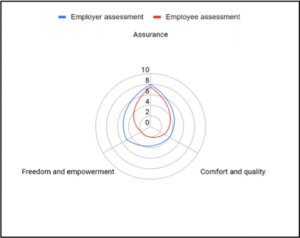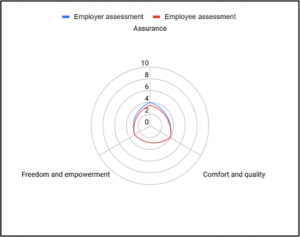In our fourth and final blog in the WorkFreeTM series, Kenneth Freeman takes a look at the WorkFreeTM assessment method.
Why do we feel there is need for our new assessment method, WorkFreeTM?
Many organisations sign up to wellbeing and sustainability standards, such as WELL, Fitwel, etc. These are excellent ways to help employers create working environments in traditional offices that are, as far as is possible, optimised for wellbeing. At least as far as the provision of a benign physical environment, products and services is concerned – there is little to account for management styles or organisational culture, which can have a profound impact on psychological comfort.
However, despite the encouragement of government, we can expect to see home working being an important aspect of many office workers’ lives for the foreseeable future. Responsible employers should, therefore, consider whether they are ensuring that their home-based workers are in healthy, safe, engaged environments, and whether they are complying with best practices as well as the law (as far as it goes).
No guidance for the long term
One of the issues uncovered during lockdown was the lack of legislation-backed guidance or codes of practice for employees suddenly finding themselves working from home. Both HSE[1] and BSI[2] produced some guidance, however, both are quite vague and limited in scope and are clearly produced with the view that homeworking is a temporary situation.
However, with the majority of UK office workers wanting to continue to work from home, for at least some of the time[3] for the foreseeable future, and many employers also planning on long-term homeworking, there is clearly a need to produce some guidance. Employers and employees need to know how to create and manage workspaces that are, and can be shown to be, safe, healthy (both physically and psychologically) and engaging. This means going beyond vague guidelines and producing robust, consistent and wide-ranging recommendations, and accompanying metrics to help employers and employees make the most of the benefits of long-term homeworking and minimise the drawbacks.
Indeed, a recent white paper[4]published by Robert Walters, entitled: “Returning to the new world of work: a practical guide for business leaders,” identifies that with as many as 73% of UK businesses planning to allow more frequent working from home (even if other restrictions are lifted), then it is vital that guidelines and rules are established, as 56% of employees feel that current policies lack clarity.
With the need for new guidance recognised, it may be tempting to look to existing standards to provide the solutions. However, it is not as simple as that.
Our new normal requires a new means of assessment
Workplace wellbeing standards, such as WELL, are valuable for purpose-designed offices. These standards are comprehensive and, with some training, relatively easy to apply. However, there is a big difference between a large corporate office building, with all the management and control systems in place, and the hundreds, if not thousands, of home offices in all their diversity and suitability. Not only are most of the criteria impossible to apply to a home working setting (even if some of an office building’s technology was available and affordable in domestic settings), they wouldn’t be desirable or practical.
Furthermore, most of the standards (WELL, Fitwel, Living Building Challenge, etc.) are more concerned with the physical environment than organisational culture. Partly, this is because if something is tangible, it is easier to assess and standardise. Other predictors of wellbeing, such as good organisational culture and management, are either assumed (because it wouldn’t be unreasonable to assume that a company investing in a wellbeing certification has a good corporate culture) or barely touched upon (staff consultation, wellness programmes, etc.).
Attempting to read these standards across to a diverse and dispersed workforce in a wide range of physical working environments is impossible. The standards were not designed for such a scenario, and are not practically adaptable to the new working situations that many find themselves in.
Several survey tools to measure ergonomics
Even if comprehensive wellbeing standards cannot be easily adapted for home or remote working, a number of useful measures have been launched to assess the ergonomics of the home workspace, especially for desks and chairs.
A good example comes from Hermann Miller[5] with its Working From Home online check-up. It assesses some aspects of the working environment, especially furniture and workspace layout, but does not address other aspects of wellbeing, such as organisational culture, air quality or regular breaks and movement.
Leesman, well known for its hugely valuable and comprehensive workplace surveys, has also recently issued a home working checklist[6]. This is a little broader in scope, but still fails to ask some critically important questions.
Returning to the insights of the Robert Walters report, there was a very apparent need to address issues of organisational culture and leadership styles. At the beginning of lockdown, many managers surveyed used traditional productivity measures, such as time spent at the keyboard or number of tasks competed. This failed to address the gross differences between a traditional office, with all its monitoring and physical oversight, and new ways of working where people often found themselves able to do their work better when given the freedom to manage their own time and space.
Some key findings from the research were:
- 67% of respondents feel their leaders could show more empathy towards their employees’ work-life balance
- 58% would like their leaders to have a better understanding of technology with regards to remote working
- 55% think their leaders should improve their communication skills
- 45% feel their leaders should move from a top down approach towards more collaboration
- 59% of employees believe their senior leaders prefer more traditional ways of working.
This last statistic is the most interesting, and perhaps worrying, as it seems to indicate a lack of belief in managers’ ability, or willingness, to change when it is those people that need to address the issues of the rapid change in working practices and environments. Plus they are often the people tasked with making fundamental, strategic changes to ways organisations operate in normal times. If senior leaders in organisations are not seen as being capable of overseeing and facilitating a move to a more dispersed way of working, what else might they not be capable of?
How do we know that home (and other remote) working environments are safe, healthy and compliant?
As previously discussed, much of the guidance issued during the pandemic to support home workers, was predicated on the assumption that this would be a short-term issue, and a return to conventional ways of working would happen quite quickly.
It is becoming increasingly evident that this is not going to be the case. This means that there is an imperative to find ways of ensuring that remote workers are looked after and that organisations gain confidence that they are compliant with health and safety rules and guidance. To achieve these aims, a comprehensive, purpose-built standard should be able to generate the data and evidence needed to benchmark health and wellbeing, set targets for improvement and confirm compliance, as far as is possible, with rules and guidelines for workplace standards.
We need perspectives from the employees as well as their employers
One of the problems with many of the traditional workplace standards, such as WELL, is the lack of the end users’ input. Workplace surveys, such as Leesman[7], rely on end user input, and employee responses to surveys to identify trends and to build upon best practices. Such an approach is useful in traditional offices, but vital where there is a highly dispersed workforce.
One of the reasons why the experiments carried out by Craig Knight and his colleagues were so robust, is that they relied on not only the participation of the end users of the office space – the office workers, but also because they gave the office workers agency over the final decision making process, over the management of their workspaces. Relying only on the points of view of an organisation’s management team is not a reliable way of getting meaningful data in a conventional workplace; it is even less reliable when managers are remote from those that they manage.
How do employers know that their staff are safe, healthy and engaged?
Employers already have some important metrics at their disposal. These include health and safety data that must be collected and reported as well as details of absence. However, such measurements are most reliable for physical conditions such as disease or injury – mental health conditions, although increasingly recognised, as an issue to address, are much harder to measure and manage.
Many companies also use regular engagement surveys. Some are more robust than others and businesses must decide whether they want the truth or just to hear what they want to hear. Even the most apparently objective and rigorous surveys, carried out by external companies (at no small cost) are subject to abuse by some unscrupulous managers who coerce, or incentivise, their staff to complete the surveys to cast them in a positive light. This is reinforced when companies reward managers that manage to improve their annual engagement scores.
Organisations with a large remote workforce have much less reliable data at their disposal. Such data is often qualitative and anecdotal in nature and is much harder to collect and analyse than when you have the workforce gathered in groups in physical offices.
Why now?
With the UK government announcing on 22 September that people should again work from home if possible, and maybe for at least another six months, temporary guidance is now no-longer appropriate. Remote working, from home or other non-traditional office settings, has now been normalised and employers must not only ensure that they can provide legally compliant working environments for their remote staff, but also, for simple business reasons. Environments that are stimulating and which promote wellbeing and engagement (rather than merely mitigating the worst effects of a poor workspace) are bound to be more productive, leading to better outcomes for organizations.
WorkFreeTM: our solution for organisations to assess and improve their homeworking arrangements
WorkFreeTM is a new assessment method for managing the health, wellbeing, safety and engagement of home-based workers. It is based on three equally important foundations, which will enable employers and employees to achieve the mutually beneficial goal of healthy, happy and effective work.
- Assurance. To enable employers to meet their responsibilities and obligations to ensure that employees have a safe place to work. This includes compliance with legal requirements, and the need to provide the necessary evidence for compliance and benchmarks for continuous improvement
- Comfort and quality. To ensure that home-based workers can set up an effective and comfortable working environment that suits them, and which gives access to a range of professional quality (but domestic scale) products to support and improve their physical and mental health and wellbeing
- Freedom and empowerment. To ensure that that home-based workers are empowered to manage their work and space. Employers must respect boundaries of privacy, minimise intrusion into the private space of their employees (physically and digitally), and recognise and respect different domestic and family arrangements without judgement
How will it be measured?
An assessment method must be robust but also practical. Data and evidence will be required from both employer (possibly from a variety of departments) as well as the home-based worker. By their very nature, such assessments are snapshots of a very particular point in time and there is always a risk that data collected will be subject to various unconscious biases and external, uncontrolled factors that might skew the results. Having said that, whether the employer or external elements affect wellbeing, there remains the fact that wellbeing has been affected and needs to be improved. A responsible employer will be concerned about employee health and wellbeing no matter the cause.
As home-based workers are, by the nature of the situation, remote from the office, all measurements will have to be in the form of surveys and data. Physical inspections will be both impractical and an unjustifiable intrusion on the private property of employees.
Employers and employees will need to complete surveys within a defined timescale and there will be a need for occasional ‘snapshot’ surveys to capture any significant changes or identify new issues to examine.
Assumptions
Good survey instruments are designed with objectivity in mind and with as many biases controlled or removed as possible. However, there are always some underlying assumptions about what constitutes a good outcome, or which generate a high score.
The new assessment tool assumes that organisations that wish to use it (and pay for it) usually are motivated to do good and that they wish to discover what needs to be done to ensure that their employees remain happy and healthy at work. The assessment tool will allow organisations to identify strengths and weaknesses and enable them to put in place processes of continuous improvement.
Our assumptions are that:
- The basic premise of identity realisation and the relationship between empowerment and outcomes is correct (based on the findings of Knight, Haslam, Postmes and Nieuwenhuis see footnotes 5, 6 and 7)
- Home working will remain a significant part of working life for the foreseeable future
- Offices will continue to exist, but their purpose and design will be different
- Covid-19 will be around for a while
- There will be greater awareness of the risk from, and the management of, other infections / outbreaks, including predictable seasonal infections as well as the risk of future pandemics.
Considerations
For a survey tool to be useful and proved truth and insight, several factors must be considered. These relate mainly to the possibly wide range of circumstances of the participants. This means that questions relating to demographics and some personal circumstances might need to be asked, although there will always be the absolute guarantee of anonymity and the right to refuse to answer any, or all, questions without fear. Such considerations might include:
- Demographics: age, gender, location, etc.
- Seniority in the organisation: this may impact on perceptions of homeworking space, and may highlight the differences in set-up that might be achieved by wealthier individuals or those with spare room in their homes
- Availability of space: some homes simply do not have the space available to set up a permanent workspace
- Other people in the same home: there is a high likelihood that home workers will be sharing their homes with other homeworkers, as well as children (especially during school holidays) and other family members.
Issues to address
The new assessment method is based on three foundations, as mentioned above:
- Assurance. This will be based on organisations having documented processes to show how they have complied with and exceeded minimum legal standards and codes of practice, and will enable a process of continuous monitoring and improvement. This will be sense checked by surveys of employees who will be asked about how they have been advised to create a safe workspace that meets standards, and whether they have been able to implement guidance.
- Comfort and quality. This relates to the physical workspace and included aspects such as the ergonomic set-up of a workspace as well as the availability of suitable products, such as desks, lighting, chairs, air quality monitors, etc., including items for enrichment of the space and improving the overall environmental quality.
- Freedom and empowerment. This will involve both the employer and home-based workers completing surveys about employees’ ability to work freely and without unnecessary intrusion. Only when employer and employee responses align will this foundation be secure.
Solution
The WorkFreeTM assessment method requires that all three foundations are aligned and that there is broad agreement between the employer scores and employee scores for each of the foundations.
The assessment method has three grades, “approved”, “good” and “excellent” and the broad criteria are summarised in the white paper, which is available for download.
Presenting the data
The following charts are examples of how different assessment outcomes can be presented.
In this example, employer and employee assessments are well aligned, fairly balanced between each foundation and all foundations have at least a good score. This example would get an overall score of “good”.

In this example, there is a discrepancy between employer and employee assessments, especially for the freedom and empowerment foundation. This example would not reach the threshold for an “acceptable score”.

This example shows an organisation that would not quite reach an “acceptable” score, but recognises that both employer and employees are aligned in their assessment. This would help an employer put in place practices and processes that would improve their score in the future.

This example shows an organisation that would achieve an “acceptable score” but could easily progress to “good” or “excellent” by putting in place better assurance processes.

This example shows an organisation that would achieve an “excellent score”. Employer and employee assessments are closely aligned and all foundations score highly.

Please contact us for more information about WorkFreeTM on WorkFree@fusion-spaces.com. Or download the white paper here.
Learn more here:
1 https://www.hse.gov.uk/toolbox/workers/home.htm
2 https://www.bsigroup.com/en-GB/topics/novel-coronavirus-covid-19/covid-19-guidelines/
3 https://wiserd.ac.uk/sites/default/files/documents/Homeworking%20in%20the%20UK_Report_Final_3.pdf
5 https://wfh.hermanmiller.com/
6 https://homeworkingsurveydemo.leesmanindex.co.uk/
7 https://www.leesmanindex.com/
